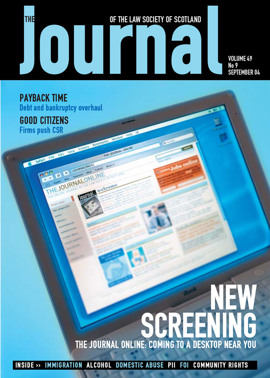Whither Whittome?
Practitioners tend to take comfort in authoritative case law, so it is perhaps worthwhile to revisit one of the pivotal cases dealing with financial provision since the Family Law (Scotland) Act 1985 and consider how it stands in today’s uncertain economic climate.
Whittome (No 1) 1994 SLT 114 looked, inter alia, at the application of the definition of “matrimonial property” to a company restructure. Lord Osborne determined on the facts that the conversion of £1 shares in a non-matrimonial private company into four 25p shares in a public company was insufficient for him to hold that the original non-matrimonial shares had been converted into matrimonial property. He was critical of Lord Marnoch’s approach in Latter 1990 SLT 805 (where the commercial facts were somewhat different, but the legal principle under discussion was essentially the same). Lord Marnoch’s later opinion in Wilson 1999 SLT 249 accepted Lord Osborne’s approach, and accordingly Whittome has tended to be regarded as the authoritative statement on this matter ever since.
Enduring
It is interesting that Whittome seems to have stood the test of time through the bubble years, and latterly the current recession. Interesting, because very few cases in this area of family law can expect to be universally authoritative and maintain that authority through changing social and economic circumstances. We tend to forget sometimes that judges have discretion, and family law practitioners would do well to include Lord Hope’s comments in Little 1990 SLT 785 in their annual review of relevant jurisprudence!
In his later commentary, Eric Clive observed by reference to case law: “It would, it is submitted, be a question of fact and degree whether more complicated reconstructions result in the acquisition of new property or simply a continuation of the old property under a new name. It is suggested, however, that if shares in a company are replaced by shares in a company which is in substance as well as form an entirely new company (as may happen, for example, when a business is split in two or more parts, or when businesses are amalgamated), then the more natural conclusion would be that new property had been acquired.” As always, each case should be considered on its own facts. Any change should trigger enquiry. Why then has there not been more in the way of significant case law on this topic since Whittome?
Scope for imagination
The volume of reported weighty family cases dealing with financial provision seems to be somewhat less than in the early years after the 1985 Act, and that is perhaps to be expected following the introduction of any radical piece of new legislation. However, if my own practice in recent years is anything to go by, there has been a continuing flow of cases under negotiation, examining the impact of business restructuring and the conversion of shares (or other business interest) which are accepted as not being matrimonial property into some new structure, where it is argued that the new product from the conversion is matrimonial property.
Farming cases in particular are notorious for this. Lord Woolman considered this briefly in Bannatyne, Greens Family Law Bulletin, November 2010. However, I wonder whether cases like Whittome, helpful though they are, may also have the impact of inhibiting family law practitioners to push the boundaries on behalf of clients? The reality is that the guidance offered in Whittome is actually rather limited in scope. Lord Marnoch made some interesting commonsense observations in Latter regarding the nature of “property” as defined in the 1985 Act and the perceived deficiency in the legislation on that point. It is important therefore that we do not close our minds to the possibilities.
At the end of the day, the 1985 Act turns around five principles of fairness, and it may be that more imaginative use of s 9(1)(b) needs to be made in cases where the fundamental argument of whether or not a conversion has given rise to a new item of matrimonial property remains unresolved. In such cases there will often be a parallel balancing argument founded on the nature and extent of “contributions”, per s 9(2).
Accordingly, in my view at least, there remains scope for developing the argument. In the current climate, many clients are fearful of incurring the substantial cost of defended litigation. That is understandable. The reality is that none but the most high value of cases is likely to run a variant of the Whittome argument, but that time must surely come?
The current economic climate is forcing businesses of all sorts to review their structures and efficiency, and I would not be at all surprised if we see a mini-tsunami of “source of funds” financial provision cases dealing with the consequences of restructuring in a few years’ time.
In this issue
- Sep rep: wrong, wrong, wrong?
- The extra e in estate
- You’re NOT fired!
- Controlling tendency
- Case closed
- “Discrimination Against Women in the Law”: a forum report
- Reading for pleasure
- Opinion column: Brenda Mitchell
- Book reviews
- Profile
- President's column
- Best measures
- Man in the hot seat
- Cohabitant awards: do they add up?
- A breach too far
- Lawyer of many facets
- Last piece of the jigsaw
- Partnerships: a firm line
- One bite at the cherry
- Whither Whittome?
- Achieving pension regime change
- Steve Webb's potty time
- Scottish Solicitors' Discipline Tribunal
- Honours shared
- e-business: call the shots
- How not to win business: a guide for professionals
- A year in focus
- Ask Ash
- Law reform roundup
- New firm, same clients?
- Diary of an innocent in-houser
- From the Brussels office






